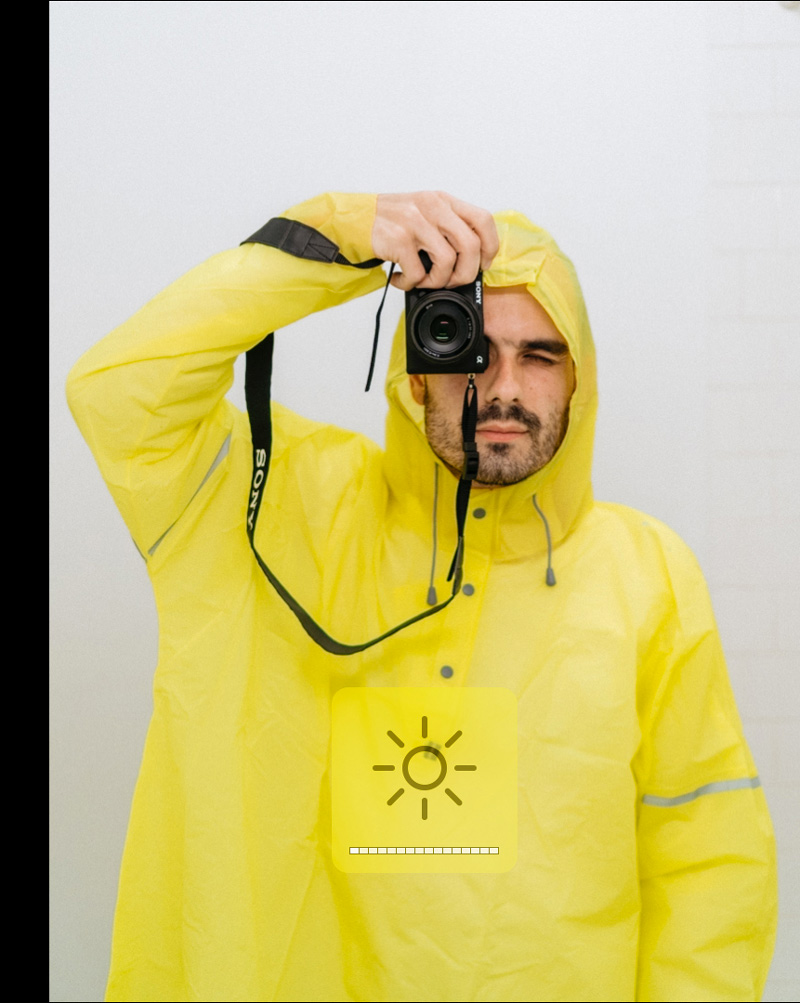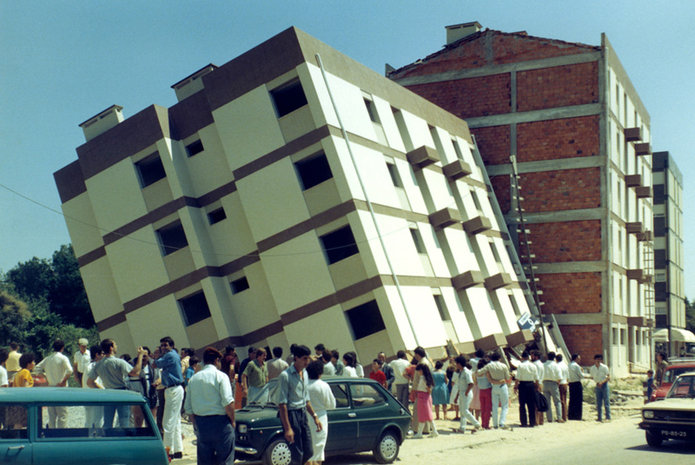Dinis Santos
Im Rahmen unseres Portugal Photography Specials wollen wir euch einen weiteren Fotografen vorstellen. In Dinis Santos Arbeiten kann der Betrachter einen kleinen Eindruck von der künstlerischen Weltsicht des Fotografen erahnen. Besonders in den freien Arbeiten des Portugiesen werden die Kleinigkeiten des alltäglichen Lebens in einem neuen Licht beleuchtet und durch spannende Bildausschnitte zu kompositorischen Kunstwerken gemacht. Wir haben mit ihm ein kleines Interview geführt und über seine Fotostrecken »The world of Yesterday«, »16 x 9 Screenshoots of photographies« und »I’ll see you around« gesprochen.
The world of Yesterday – 2015
The works shown on your website are not marked with a specific date, so I looked at Instagram to have a look at your most recent work. I would – most carefully – describe your photographs as artistic and rather quiet. Does that reflect how you see your own style?
Well, I've studied painting at Porto’s Fine Art School so I guess that has something to do with what you call “artistic” on my photographs. The way I compose and look to things I’m going to photograph is the same way I used to look and draw. I think I can agree with you when you say that my pictures are quiet. I like that feeling. I think I like images that seem not say anything at the first place. They stand there mysterious and quite and you never know if at a certain point they will reveal something. You know, in Portuguese the word that we use to say development or processing is “revelar” – to reveal. Photography is assumed as a proof of reality, video and photographic images are used to prove crimes, used in the news as evidences and in the social media the images are used to prove ourselves that we exist, that we are socially accepted and happier than everyone else. Even if everyone knows that images can be so manipulated as a text or a speech. So, I think I prefer quiet and simple images that apparently don’t say too much. And I think that makes part of the seduction of a good image (it also works for people :) ).
16 x 9 Screenshoots of photographies – work in progress – 2013–2015
Are you a “slow” and considered photographer, and only carrying the camera with you when you want to shoot; or are you a spontaneous photographer? How do you photograph and how do you describe your style?
When I was studying painting I didn’t have my own camera. I had to use the school’s digital cameras or the hasselblad medium format camera (oh I miss her so much :) ). I also had my father’s 35mm fujica. So I wasn’t used to carry a camera everyday and there were no cameras in the mobile phones :). But now I like to carry my camera sometimes but I’m not that crazy guy that always carries his camera. But I try to practice photography every week. Sometimes I take a photo of a beautifull light that I see at my house or something like that.
I see this type of photography as an exercise, like when I used to draw my own hands to practice. The hands where the “thing” that was always around and that I could look at and draw. I also find quite interesting the emptiness of the daily routine. And some of my works are about this and the middle class existence. Middle class as it’s name suggests is a middle thing, something in between, caught in the middle of the class struggle, bought with the social democracy rights and achievements. Middle class doesn’t have it’s heroes or narratives to picture or talk about. Who wants to know about someone who lives in the limbo? Hell and heaven are more exciting. But well I was born in a middle class family, that lived in a middle class building, in the second floor that was in the middle, between the first and the third … but you know middle class in Portugal is getting so poor that maybe in 1 or 2 years I might have different pictures to show.
There’s another thing about quietness that interests me. The quiet before and after something dramatics happens. Europe is facing dramatic events these days. But life continues quietly in it’s mysterious form. In 2015 I read The world of yesterday, from Stefan Zweig where he explains how europeans couldn’t believe that a war was coming (before the first and second world wars). And the way he describes it is frightening. In some ways it resemble the days we are facing. These photos where about this book and this feeling. It would be good if you could translate the text :) – it’s from the book and it’s a good description of Europe.
16 x 9 Screenshoots of photographies – work in progress – 2013–2015
How do you make your living by being a photographer in Portugal? By commercial work (i.e. advertising) or by selling prints? Aontracted art projects or self-initiated ones?
I think you could ask how do you survive in Portugal … But as a photographer I do a lot of different things. As I said I’ve studied painting so I had to make my own path on photography. I didn’t get out of the school with a portfolio of images that could get me some jobs. I didn’t had product photography, fashion, advertising or photojournalist images. I just had some bizarre images done in studio :). But even though I could get to work doing product photography at Diocese do Porto (the Church), doing photos of old sculptures and jewelry. Then I learned some things being a fashion photo assistent in some fashion studios in Lisbon. Nowadays I have some clients as a photographer and as a videographer but unfortunately I couldn’t specialize in just one area, yet. The artistic work is done, most part of the times, on my own but sometimes I’m invited to an exhibition.
16 x 9 Screenshoots of photographies – work in progress – 2013–2015
Do you rather work in Portugal or outside? If outside, where?
I like to live in Portugal and especially in Porto because of the scale it has. It’s a big small town. I live in the center I grab my bike and I go to every place I want in few minutes. We have the ocean nearby and the mountains. We also have a lot of things going on here.
But unfortunately last years of austerity destroyed our economy and sent a lot of friends to outside of Portugal. We the resistants ;P miss our friends. And when you see a lot of good people with amazing work and ideas going out you think that maybe you should join them in the “exile.”
Besides that I would like to have the experience to work outside. I would like to see what’s going on in China. And actually I’m trying to go to Israel to visit a friend and try to make some photographs there. I think Israel / Palestine are for the best ad worst reasons very important to our civilization. Also I would like to visit Rojava but I m not sure if I have the courage to do it.
Thank you very much for the interview.
First image: print from a personal photography of Ana Remelhe used by Dinis Santos on his work 1991
16 x 9 Screenshoots of photographies – work in progress – 2013–2015
16 x 9 Screenshoots of photographies – work in progress – 2013–2015
16 x 9 Screenshoots of photographies – work in progress – 2013–2015
16 x 9 Screenshoots of photographies – work in progress – 2013–2015
16 x 9 Screenshoots of photographies – work in progress – 2013–2015
16 x 9 Screenshoots of photographies – work in progress – 2013–2015
16 x 9 Screenshoots of photographies – work in progress – 2013–2015
16 x 9 Screenshoots of photographies – work in progress – 2013–2015
16 x 9 Screenshoots of photographies – work in progress – 2013–2015
16 x 9 Screenshoots of photographies – work in progress – 2013–2015
16 x 9 Screenshoots of photographies – work in progress – 2013–2015
I’ll see you around – 2016
I’ll see you around – 2016
I’ll see you around – 2016
I’ll see you around – 2016
I’ll see you around – 2016
I’ll see you around – 2016
I’ll see you around – 2016
I’ll see you around – 2016
I’ll see you around – 2016
Dinis Santos hat einen Abschluss in Malerei von der Hochschule der Künste in Porto und studierte außerdem zeitgenössische Philosophie. Seit 2007 arbeitet er als freischaffender Fotograph und Video Editor. Neben seiner kommerziellen Arbeit konzentriert er sich auf die Weiterentwicklung seiner Fotografie. Dabei sind seine speziellen Interessensgebiete das mittelklasse Leben und Politik.

























